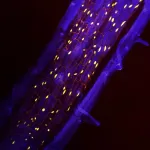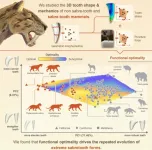(Press-News.org) Researchers have uncovered how egg cells prepare for the creation of life. Their work reveals the secrets of the Balbiani body, a remarkable structure that organizes essential molecules to guide early embryonic development. Using zebrafish models and cutting-edge imaging, the team discovered how this structure transforms from liquid droplets into a stable core, laying the groundwork for life itself. This discovery sheds light on the extraordinary precision of nature’s reproductive process.
A new study led by Prof. Yaniv Elkouby and his team, including first co-authors Swastik Kar and Rachael Deis, from the Faculty of Medicine at the Hebrew University and the Institute for Medical Research – Israel-Canada (IMRIC), has provided valuable insights into how cells organize themselves to create life. For over 200 years, scientists have observed the unique polarity of oocytes—immature egg cells—necessary for embryonic development, but the mechanisms behind this process have remained a mystery. This research, published in Current Biology, brings us closer to understanding these critical biological events, with implications for reproductive health and developmental biology.
A key focus of the study is the Balbiani body (Bb), a structure inside the cell that lacks a surrounding membrane. Its job is to gather and organize important molecules, like ribonucleic acid (RNA) and proteins, which are crucial for the egg cell’s proper orientation and the early development of the embryo. The Balbiani body is found across many species, from insects to humans. Using zebrafish as a model, the researchers revealed how the Balbiani body forms, utilizing advanced tools such as super-resolution microscopy and live imaging of the fish's entire ovaries.
The study highlights the role of a protein called Bucky ball, which drives the formation of the Balbiani body through phase separation—a process where molecules transition from being dissolved in the cell to becoming more condensed, eventually forming a more solid-like, stable structure. The team tracked the activity of the Bucky ball protein, showing that it starts as liquid-like droplets that later stabilize into a cohesive solid-like compartment. This transformation is crucial for the structure and function of the Balbiani body, which are vital for successful embryonic development.
The researchers also uncovered the essential role of microtubules, cellular structures that regulate the assembly of the Balbiani body. Microtubules guide the movement of the Bucky ball protein granules, ensure their proper organization, and prevent overgrowth, maintaining the shape and functionality of the Balbiani body. This precise orchestration results in the formation of a single, intact Balbiani body, a key element in reproduction.
While Bucky ball has been the single known essential gene for Bb formation in any species, the researchers have now uncovered a list of novel strong candidate regulators through unique proteomic approaches. This discovery is significant in paving the way to deciphering the complete mechanisms of Bb formation and oocyte polarity. This knowledge will be crucial for advancing understanding of the human Bb, whose content, function, and regulation remain a mystery, and could have profound implications for women’s reproduction and health.
Beyond reproduction and embryonic development, the study has broader implications. Solid-like structures in cells are mostly known from pathological contexts, such as prions, which irreversibly form and damage cells, causing neurodegenerative diseases. In contrast, the Balbiani body forms in a physiological developmental context in a regulated manner and is reversible. As the Bb disassembles, it delivers RNPs (ribonucleoproteins) to the oocyte cortex. This fundamental research using zebrafish oocytes can provide new insights into understanding pathological mechanisms in neurodegenerative diseases.
Dr. Elkouby explained the significance of these findings: “We have uncovered how the Balbiani body forms through molecular condensation and how microtubules regulate this process. This discovery helps answer long-standing questions about how oocyte polarity and embryonic development are initiated.”
The study offers new perspectives on the origins of embryonic polarity in vertebrates, highlighting the complex interactions between molecular and structural components in cellular organization. These findings not only enhance our understanding of developmental biology but may also inform future research on reproductive health.
END
The Balbiani body: Cracking the secret of embryonic beginnings
2025-01-09
ELSE PRESS RELEASES FROM THIS DATE:
Science behind genetic testing for identifying risk of opioid misuse remains unproven
2025-01-09
PHILADELPHIA—Opioid misuse and specifically opioid use disorder (OUD), continues to represent a significant U.S. public health threat, with more than 6 million Americans aged 12 and older meeting the criteria for OUD in 2022. Efforts to ease the crisis have included the development of genetic testing to identify individuals most at risk for OUD. New research, out today in JAMA Network Open, questions the usefulness of 15 genetic variants from an algorithm meant to predict OUD risk that was recently granted pre-marketing approval by the Food and Drug Administration. It found that the testing could lead to both false positive and false negative results.
The study was led by Christal ...
Two-in-one root armor protects plants from environmental stressors and fights climate change
2025-01-09
LA JOLLA (January 9, 2025)—Plants may burrow into the ground and stretch toward the sun, but they’re ultimately stuck where they sprout—at the mercy of environmental threats like temperature, drought, and microbial infection. To compensate for their inability to up and move when danger strikes, many plants have evolved ways to protect themselves by altering their physiology, such as building armor around parts of their body and roots called the periderm. However, since many plant biologists who study tissue development ...
The extreme teeth of sabre-toothed predators were ‘optimal’ for biting into prey, new study reveals
2025-01-09
Sabre-toothed predators – best know from the infamous Smilodon – evolved multiple times across different mammal groups. A new study, published today in Current Biology reveals why: these teeth were ‘functionally optimal’ and highly effective at puncturing prey.
The study, led by scientists at the University of Bristol in collaboration with Monash University shows that long, sharp blade-like teeth gave sabre-tooth’s a real advantage as ...
Research spotlight: Factors contributing to treatment resistance in CAR T therapies for solid tumors
2025-01-09
Russell W. Jenkins, MD, PhD, a physician investigator in the Krantz Family Center for Cancer Research at the Mass General Cancer Center and an assistant professor of Medicine at Harvard Medical School, is senior author of a new study in Cancer Immunology Research, “TBK1 is Identified as a Therapeutic Strategy to Enhance CAR T-Cell Efficacy Using Patient-Derived Organotypic Tumor Spheroids”.
The study was a collaboration with the late Soldano Ferrone, MD, PhD, and was carried across the finish line by his daughter Cristina Ferrone, MD, Moshe Sade-Feldman, PhD, and several other collaborators ...
New findings could lead to better treatment for blood cancer
2025-01-09
Which medicine is best when you are affected by cancer? This can vary from person to person. A new method can help people with a specific type of blood cancer get the best medicine for them.
“The new method can help those affected by chronic myelogenous leukemia,” says Jennifer Sheehan, a PhD research fellow from the Department of Mechanical Engineering and Production at the Norwegian University of Science and Technology (NTNU). Sheehan was first author of a new publication in PLOS Computational Biology that describes ...
Expanded research on COPD and metabolic syndrome would advance patient-centered care
2025-01-09
Miami (January 9, 2025) – Additional research addressing the connection between chronic obstructive pulmonary disease (COPD) and metabolic syndrome is needed to improve holistic patient care, according to a new editorial. The editorial is published in the November 2024 issue of Chronic Obstructive Pulmonary Diseases: Journal of the COPD Foundation, a peer-reviewed, open-access journal.
COPD is an inflammatory lung disease, comprising several conditions, including chronic bronchitis and emphysema, and can be caused by genetics and irritants like smoke ...
Mount Sinai-led team enhances automated method to detect common sleep disorder affecting millions
2025-01-09
A Mount Sinai-led team of researchers has enhanced an artificial intelligence (AI)-powered algorithm to analyze video recordings of clinical sleep tests, ultimately improving accurate diagnosis of a common sleep disorder affecting more than 80 million people worldwide. The study findings were published in the journal Annals of Neurology on January 9.
REM sleep behavior disorder (RBD) is a sleep condition that causes abnormal movements, or the physical acting out of dreams, during the rapid eye movement (REM) phase of sleep. RBD that occurs in otherwise healthy adults ...
Dr. Ruth Westheimer, Dr. Helen Fisher, and Dr. Judith Allen donate historic archives to the Kinsey Institute
2025-01-09
The Kinsey Institute at Indiana University has acquired remarkable archives from three pioneering figures in the study of human sexuality, relationships, and wellbeing: the legendary sex therapist Dr. Ruth Westheimer, renowned anthropologist Dr. Helen Fisher, and respected feminist historian Dr. Judith Allen. These invaluable collections represent decades of groundbreaking research, education, and cultural contributions that will advance future scholarship and research.
“For almost 80 ...
Bridging oceans: A US-Japan approach to flood risk and climate resilience
2025-01-09
An innovative project jointly funded by the United States National Science Foundation (NSF) and the Japan Science and Technology Agency (JST) brings together a team of scientists from Florida Atlantic University and Lehigh University, along with a team from Japan that includes researchers from Kyoto University, University of Tokyo and Kumamoto University.
The project, titled “NSF-JST: An Inclusive Human-Centered Risk Management Modeling Framework for Flood Resilience,” is supported by a three-year, $1 million award split evenly between the U.S. and Japanese teams, with the U.S. team receiving $499,271. ...
Dense human population is linked to longer urban coyote survival
2025-01-09
COLUMBUS, Ohio – Tracking coyote movement in metropolitan areas shows the animals spend lots of time in natural settings, but a new study suggests the human element of city life has a bigger impact than the environment on urban coyote survival.
Researchers monitoring coyotes in Chicago found that habitat – areas with relatively high levels of vegetation cover and low levels of human infrastructure – did not influence coyote survival in positive or negative ways. Instead, areas densely populated with humans were ...



